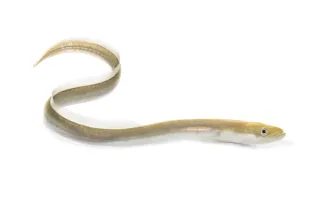Migration is a fascinating natural phenomenon, perhaps best known from stories about geese and even butterflies flying south for the winter. But migration isn't limited to overland passages. A number of Oklahoma fish species are aquatic explorers that move up and down our rivers and streams as they spawn and complete other life requirements. This makes intact rivers, unobstructed by dams and other barriers, especially important.
Among Oklahoma's aquatic explorers are three species considered to be of greatest conservation need.
American Eel

The American eel spends most of its life in its freshwater "yellow eel" stage. This aquatic explorer is sporadically found in the eastern half of the state.
One of Oklahoma's most epic fish migration stories begins and ends in the Sargasso Sea, south of Bermuda. American eels hatch in the ocean and the willow leaf-shaped larvae continue to develop as they float with the current to the Atlantic Coast. After arriving, the juvenile eels transform into their gray to greenish-brown "elver" life form and move inland to more brackish waters. Eels continue moving inland and find freshwater homes in their next life stage. These "yellow eels" are nocturnal and can be found in Oklahoma's rivers and streams. The snake-like fish begin to mature after 5 to 25 years and make a return trip to the sea where they spawn and are assumed to die.
Shovelnose Sturgeon

With their flattened heads and vacuum cleaner-type mouths, shovelnose sturgeon may be likened to living pool cleaners.
Shovelnose sturgeon are homebodies for much of the year, preferring to stay at the bottom of the river in one general vicinity for several months. But when spring temperatures reach 65 to 70 degrees, the fish turn into aquatic explorers and begin to migrate upstream for their annual spawn. Once the resulting eggs hatch, the young sturgeon need to float downstream for seven days as they continue to develop. This strategy makes them especially reliant on long stretches of free-flowing water.
To better understand these strange fish, the Wildlife Department implanted ultrasonic tracking devices in 25 shovelnose sturgeon captured in the Arkansas River. Biologists were able to track a few of the sturgeon's movements and found "hotspots" or centers of activity. One of the study's fish moved between two hotspots located 16 miles apart in a mere 17 hours. Learn more about the study.
American Paddlefish

Paddlefish are filter feeders. They swim through the water with their mouths open to collect and feed on microscopic plankton.
High spring flows trigger the spawning runs of one of Oklaoma's most recognizable fish, the paddlefish. Once upriver, these aquatic explorers wait until water temperatures reach 55 to 60 degrees before spawning over gravel. Male paddlefish reach maturity at around 15 pounds and can spawn each year, but females mature at closer to 30 pounds and may not spawn every year.
Paddlefish can move and mix in open river habitats (and rivers with locks and dams) and fish snagged within our state's Arkansas River watershed may have originated from a number of sources within the greater Arkansas River watershed in Oklahoma, Arkansas or Louisiana. The largest documented paddlefish movement exceeded 1,400 miles.